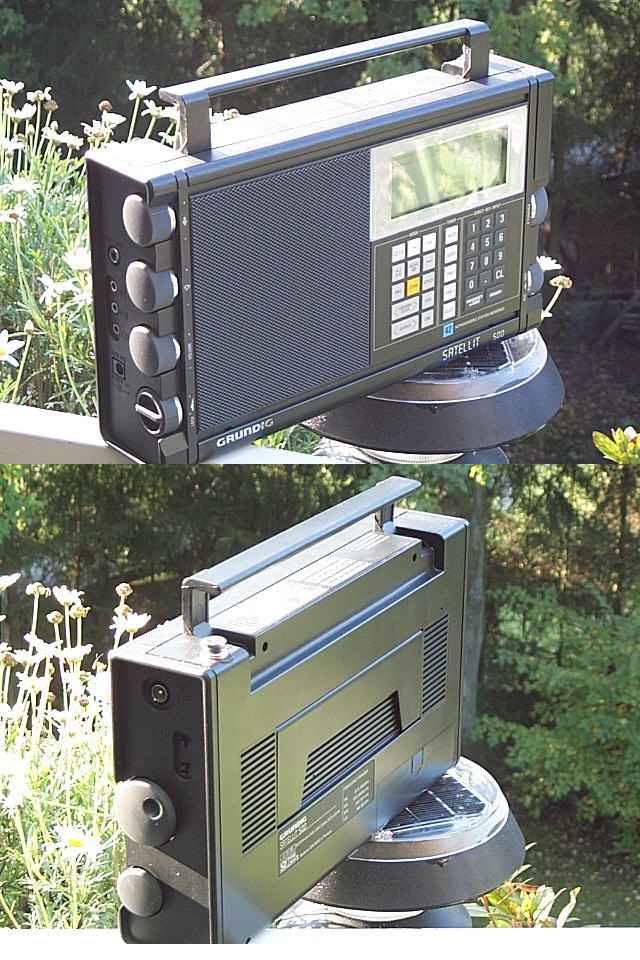
Radio Boy
Satellit 500 - 1989-1991

Photo's by Thomas
Baier.
3 basic versions of this
set were made: The "Professional" version, which was sold in Germany, had
SW coverage of 1612-26100 kHz & LW coverage 150-353 kHz, plus a 156
frequency/40 broadcaster ROM table. The "Italia" version had reduced coverage
to meet Italian regulations, (SW: 3900-26100 kHz, LW 148-302 kHz), and
no ROM table. The "International" version, for all markets bar Germany
and Italy had full 1612-30000kHz SW and 148-353 LW, with no ROM Table.
In December 1990, the
ROM table was included in all the 500's, and the "Professional" version
had its SW coverage increased to 30000kHz, thus making the "Professional"
and "International" the same.
To see details of the
ROM table contents, click here.
Unlike the Satellit 700
and the Sony ICF2001D/2010, this radio did not have selectable sideband
Synchronous detection. Instead, it has Synchronous Dual Sideband Demodulation,
thus you cannot select a sideband away from an adjacent strong station,
but you can tune away from it using the fine tune option, which is what
the button marked "Synch" allows you to do. The point here is that the
radio does "Lock" onto the frequency being received, and this has been
confirmed by Grundig design engineers in the past. It may be an inferior
system to the full selectable sideband version, but it is better than nothing,
and on occasions, can be the better option.
This particular set, a
late model international, with ROM table and full coverage, was bought
from Thomas Baier, author of "Grundig Satellit - all models in word and
picture".
Specification:
Styling:
Similar in size to the
300 & 400, this set had a new style which was inherited by the 700,
as the 400 had from the 300. The audio controls were moved from centre
stage to the left side, clever design making them accessible from the front
or the side. This resulted in the front of the 500 & 700 having 3 main
areas, instead of the 4 on the 300 & 400.
The speaker grille still
took up most of the left side, with an identical layout of keys to the
700, though some of the functions were changed for the 700. The LCD
display caters for a much bigger range of functions then the 400.
Thus the styling stands
out from any other radio, with one exception: The 700, though much different
inside, and lighter coloured, looks much the same.
Country of manufacture: Portugal.
Size: 178mm high x 304mm
wide x 66mm deep.
Weight (excluding batteries):
1.8 kg.
Power supply:
Internal; 4 x D cells,
6V, or 4 x rechargeable D cells, 4.8V.
External; 9-12V DC, NR90
100-127V/220-240V mains unit is included. NiCD charger built into set,
charges if switch in battery compartment set to "ACCU" and external power
supply connected, even if set switched off.
Battery meter:
Yes, in LCD panel, displays
for 10 seconds after switch on.
Tuning method: Digital PLL
synthesizer
Tuning options:
Tuning knob
Slew key
Auto-search (FM)
Auto-scan (AM)
Direct keying-in of frequencies
and SW metre-bands, (LW/MW/SW frequencies can be entered in kHz or MHz,
FM in MHz only)
40 broadcaster/156 frequency
ROM table.
User programmable presets
Manual or automatic ROM/memory
scan
SW metre-band skip.
Wavebands:
FM: 87.5-108 mHz, tuning
steps 25kHz.
LW 148-353 kHz, modes: Synchronous
AM/USB/LSB; tuning steps 9kHz (scan), 1kHz (manual tuning), 100Hz (manual
SSB/Synch fine tuning). Bandwidth. Automatic/Manual Gain Control.
MW 513-1611 kHz, modes:
Synchronous AM/USB/LSB; tuning steps 9kHz (switchable to 10kHz for use
in the USA) (scan), 1kHz (manual tuning), 100Hz (manual SSB/Synch fine
tuning). Bandwidth. Automatic/Manual Gain Control.
SW 1612-30000kHz, modes:
Synchronous AM/USB/LSB; tuning steps 5kHz (scan, within metre bands only,
including amateur bands), 1kHz (manual tuning), 100Hz (manual SSB/Synch
fine tuning). Bandwidth. Automatic/Manual Gain Control.
IF's:
FM; 10.7 MHZ
AM; 54.5 MHz & 450
kHz. (Dual conversion)
Station memories: Yes;
42, stores mode, bandwidth
and mono/stereo where appropriate, with 4 character user input alphanumeric
name assignment.
ROM table, where applicable.
(See above)
Tuning meter: Yes, 16 segment
LCD.
Local/DX switch: Yes.
Aerials: Ferrite rod for
LW & MW, Telescopic for FM & SW, with internal pre-amp for SW.
Dial illumination: Yes,
plus numeric keypad and on/off key;
Battery; Switched
on for 10 seconds at switch on or when any key on numerical pad pressed.
External power; permanent,
but at reduced level when switched off.
Mono selector: Yes, with
LCD indication when stereo being decoded.
Sockets:
Inputs;
DC 9-12V
Aerial (all wavebands).
Switch selectable on SW & FM,
Outputs;
Mono Line-out, phono
socket.
Stereo headphone (activates
Stereo decoder if FM in use). Can also be used for cassette recording in
stereo, in addition to line-out sockets.
External speaker, left
channel. (Internal speaker becomes right channel)
Remote timer switching
for external tape recorder, 3.5mm 3-contact, (sleeve common, ring open
when timer on, tip closed when timer on)
Output power:
Mains operation; 2 x
1.5W RMS.
Battery operation;
2 x 1W RMS
Speaker: 4 inch dia.
Tone control: Bass, Treble.
Clock/Timer:
2 x 24 hour clocks, either
one displayed full time, with keys to select.
2 x user programmable
timer settings for on, off, station (memory or manual tuned).
Sleep timer, programmable
in 10 minute steps up to 60 minutes.
Satellit
500 FAQ file
Read
my review of this radio


